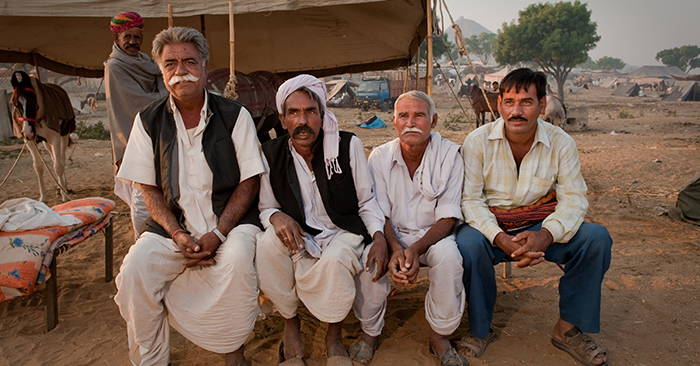In case you previously missed it, here is a great article from the content library archive, first published here March 17, 2017.
By Kärin Butler Primuth on Mission Frontiers
In the late 1980’s, David Barrett and James Reapsome published a book titled Seven Hundred Plans to Evangelize the World. In their book, they identified lack of cooperation and collaboration between Christian organizations as a major hindrance to world evangelization. Of all the hundreds of plans for global outreach they reviewed, 66% were completely stand-alone plans – each viewing itself as the sole center of world evangelization. The authors estimated that 96% of all plans for world evangelization ignored or disregarded other Christian traditions, leaving only 4% which sought to network or connect in any meaningful way with other Christian groups.[1]
That was the state of world mission 30 years ago. The good news is that much has changed since then. God is now uniting the worldwide Church like never before to reach the unreached.
Over the past several decades, an increasingly interconnected and globalized world has given rise to hundreds of networks in every field of mission. Through these networks, ministries around the world are meeting, sharing information and resources, and collectively working together to respond to some of the greatest challenges and opportunities of our day. These mission networks are now playing a vital role in shaping Great Commission strategies and the future of the world mission movement.
Networks in Every Field of Mission
The landscape of mission networks today is staggering. There are hundreds of networks around the world covering a wide variety of mission fields at global, regional, national, and local levels. Each network draws together dozens if not hundreds of individuals and organizations around common areas of interest – whether that is a focus on particular geographic areas, people groups, mission strategies, or other issues.
The resource website Linking Global Voices currently tracks more than 500 different networks around the world. And many of these networks have sub-networks within them!
The Lausanne Movement, as one example, is organized around 12 geographic networks and an array of 37 separate global issue networks – from the Buddhist World to Business As Mission, from Diasporas to Disability Concerns, from Leadership Development to Least Evangelized Peoples.
Some mission networks function primarily for information sharing, while others are highly participatory, with members contributing resources toward collaborative projects and commonly-defined goals. With such a tremendous range of opportunities for engagement, it should be no surprise that participation in networks is becoming a high priority for many mission leaders and organizations.
A growing number of churches, ministries, and mission organizations see their participation in networks as essential to making informed decisions and fulfilling their own calling.
Three Benefits of Participation
While there are many benefits of participation in networks, there are at least three key benefits that are driving the growth of mission networks around the world.
1. Networks provide access to vital information, resources, and best practices to inform mission strategy.
Participants in mission networks gain exposure to people who think differently from those inside their own ministries. Many networks draw from a breadth of different cultures, theological perspectives, and ministry methods. This leads to a broader and richer perspective for all participants.
Networks offer the most current and comprehensive view of how God is at work and who is involved in a particular ministry field. By bringing together people with a wide range of expertise, networks provide access to information not available within a single organization, even a large global mission agency. Networks provide a platform to aggregate best practices from across organizations, and to showcase what is working and learn from what is not working.
Connecting to these networks enables participants to more effectively shape their mission strategies in light of rapidly changing realities. Access to this kind of information can significantly increase ministry effectiveness by eliminating duplication and increasing cooperation. In addition, networks help reduce costs as participants glean from what others are learning and utilize shared resources, rather than having to start from scratch to develop their own.
Network Spotlight
The “Muslim Internet Evangelism Network” (name changed for security reasons) is one example of a highly influential network focused on using the Internet and digital media for evangelism in the Muslim world. The network now has over 700 members from 35+ different countries and 70+ different organizations. At a recent network gathering, more than 30 participants were Arab, including many believers from Muslim backgrounds. This provides an excellent opportunity for the voice of national leaders from the region to be heard as attendees gather to explore new technology and assess Internet evangelism strategies focused on the Muslim world. The network has provided training for participants on cutting-edge social media and Internet evangelism approaches. Hundreds of resource-sharing partnerships and joint projects have been generated by the network over the years.
2. Networks provide opportunities to partner with the rapidly growing Church and expanding mission force of the Majority World.
Hans Rosling – famed Swedish doctor, professor of global health, and frequent TED Talks presenter – has said that if we want to update our mind-set, we must first update our data-set. Too many mission leaders are operating under false assumptions and outdated models. This is especially true when it comes to the current realities of mission sending.
The face of the mission sending world is changing dramatically as the center of gravity is shifting from the Western World to the Majority World. Those who were previously receivers of missionaries have now become some of the most vital mission-sending churches in the world. While North America and Europe still send many missionaries, mobilization efforts from the Majority World have experienced exponential growth in recent decades.
For example, Brazil, Korea, and India are among the top ten mission-sending countries. China has hopes of equipping 20,000 missionaries in the next twenty years. Nigeria has the fourth largest number of evangelical Christians in the world, and is one of the fastest-growing mission-sending countries. Over 20,000 Africans currently serve as missionaries outside their own countries.
In fact, this is a cause for great rejoicing! At the same time, these changing dynamics have left many mission organizations in the West struggling to understand their future role. One of the great benefits of global mission networks is the level playing field they provide. By participating in these networks, Western mission organizations now have the opportunity to genuinely listen and learn from partners in the Majority World and to work together to clarify their unique contributions in the world mission movement.
Network Spotlight
Many networks that were originally started by Western leaders now have significant participation and leadership by nationals. The “Central Asia Consultation”, for example, was originally started by Western individuals praying for that region. At a recent network gathering, they experienced a great moment of celebration when they realized that of the almost 400 attendees at the consultation more than 60% were nationals from the region. The leadership council of that network is now 90% nationals.

3. Networks enable participants to leverage their mutual strengths to accomplish more together than is possible by any individual or organization alone.
At the heart of every effective mission network is a vision to address a critical or strategic challenge that is beyond the scope of any single individual or organization. Networks create shared value through the intersection of ideas and expertise than can foster innovation, collaboration, and ultimately, Great Commission breakthroughs.
At a deeper level, these multicultural networks are one of the most visible and functional demonstrations of unity in the Body of Christ. In a world that is increasingly divided by race, culture, and religious identity, networks create a means for the global Church to demonstrate a powerful witness through unity, love, and partnership.
Network Spotlight
Not long ago, the “Maghreb Network” (named changed for security reasons) was formed with a focus on an unreached North African country. This network has grown from 13 initial partners to now over 70 partners that are coordinating efforts to see a thriving indigenous Church in the country. Their early dream of placing just a handful of workers on the ground has now grown to an active facilitation team coordinating multiple working groups focused on business as mission, English as a Second Language, church planting, relief and development, and prayer. They share information on a secure website open only to network members, and coordinate in-country visits, projects, and employment opportunities. This network provides a rich source of information and collaboration for workers on the ground, ministry leaders, donors, prayer supporters, and partnering churches. Recently, some national believers who are members of the network launched the very first online church for the handful of scattered believers in the country.

Four Positive Trends
There may still be thousands of mission groups and hundreds of thousands of local churches around the world who continue to go it alone in their ministry fields. Nevertheless, the good news is that collaboration is gradually becoming the default approach to ministry – from international mission agencies working together among the unreached to local churches working together in their communities.
There are four positive trends that point to a tectonic shift toward collaborative networks in the global mission community.
1. Increasing awareness of networks
There is a growing awareness of and openness to networks and partnerships among churches, ministries, and mission organizations around the world.
2. Donors investing directly in partnerships
The mission funding community is shifting more of their kingdom investments toward projects initiated by networks and partnerships. Many major donors now explicitly ask grantees how they are working in partnership with others to accomplish the goals of their project proposals.
3. Inter-network cooperation
Many networks share common operational challenges. Increasingly, representatives of multiple networks are coming together to share knowledge and address issues particular to multilateral mission networks such as information security and regionalization.
4. Collaboration-friendly organizations
There are thousands of churches and mission organizations which participate in networks around the world. The same individuals or organizations are often involved in multiple networks. The growing number of these collaboration-friendly organizations is a tremendous sign that the mission community is shifting to a new future.
Three Steps to Involvement
As God continues to unite the Church to fulfill the Great Commission, networks will have an increasingly vital role to play. If you are a church or ministry leader and are not yet involved in a mission network, take time to explore where you could both benefit and contribute.
Here are three practical steps to intentional involvement in high-impact mission networks.
Step 1. Take a look through a “microscope” – Internally assess which of your mission priorities would most benefit from network participation.
Are you considering expansion into new fields and need a better sense of what’s really happening in the region? Who is there, and what resources are needed? Do you have emerging issues in which you don’t have expertise and you need to find others who do? Identify areas where you do have expertise and consider who else you can connect with to potentially collaborate.
Step 2. Take a look through a “telescope” – Externally assess what high-impact networks already exist and who would be the best representative for participation.
Not all networks are truly effective. Not all have strong leadership structures or are effectively working toward shared goals. Talk to people you know who are involved in networks and find out the value they have gained or not. Visit network consultations and find out what’s happening.
Be intentional to provide your best and brightest for the greatest kingdom contributions but don’t appoint someone to get involved in a network without making their participation part of their job description so they have the capacity to really contribute.
Step 3. Take a look through a “kaleidoscope” – Develop a collaboration-friendly culture that actively engages in mission networks.
High-impact networks need dedicated leaders who have the time to commit to the network. That can only happen if their various organizations are willing to give some portion of personnel time to the network because they can see how the goals of the network would also advance the goals of their organization.
High-impact networks also need sustainable resources. If more mission organizations really understood the power of networks to leverage kingdom resources, they would be allocating more funding and other non-monetary resources to networks to help them accomplish their shared goals.
Moving to the Center
If you’re already involved in a network, then consider what steps you can take to move closer to the center, where you will find greater value and also make a greater contribution toward helping the network achieve its vision.
So how do you move to the center of a network and gain access to that value? First, you have to know clearly why you are there so you can set your priorities.
It begins with asking two key questions:
First, what is it that you or your organization need that this network might provide? Is it information, resources, or specific skills? By having a clear understanding of what you need, you will have a better chance of finding people in the network who can help you. If those people don’t have what you need, they will likely know someone who does. Networks are valuable not only because of the people who are in them, but because of the people those people know and can connect you with.
Second, what can you contribute? Can you give time, leadership, expertise, organizational resources, information, or personnel? The more willing you are to contribute, the more quickly you will connect with others who also need what you have to offer. And all of that moves you more quickly to the center, where you will have the greatest opportunities for connections and access to important resources. By understanding what you need, you can prioritize finding people who can help you.
As you explore and engage more deeply in mission networks, I am sure you will become convinced as I am that Christians are called to work together and that partnership is the single best strategy for addressing the most pressing needs in the world today. Collaboration is the key that reduces the duplication of our efforts, maximizes the impact of our ministries, and strengthens the credibility of our witness for Christ.
“My prayer is not for them alone. I pray also for those who will believe in me through their message, that all of them may be one, Father, just as you are in me and I am in you. May they also be in us so that the world may believe that you have sent me. I have given them the glory that you gave me, that they may be one as we are one – I in them and you in me – so that they may be brought to complete unity. Then the world will know that you sent me and have loved them even as you have loved me.”
John 17:20-23
Resources
Information about network advisory services and resources: visionsynergy.net
Free handbook on mission partnerships available in multiple languages: bit.do/wellconnected
Online learning community for network leaders: synergycommons.net
Information about global, regional, country, and issue networks: linkingglobalvoices.com
[1] Robb, J. (1999). The Field Based Network. Retrieved 31 July 2015 from http://www.webcitation.org/6aQBVq5Fk
« Orality In the Academy and Beyond Training Translators with an Oral Foundation »






